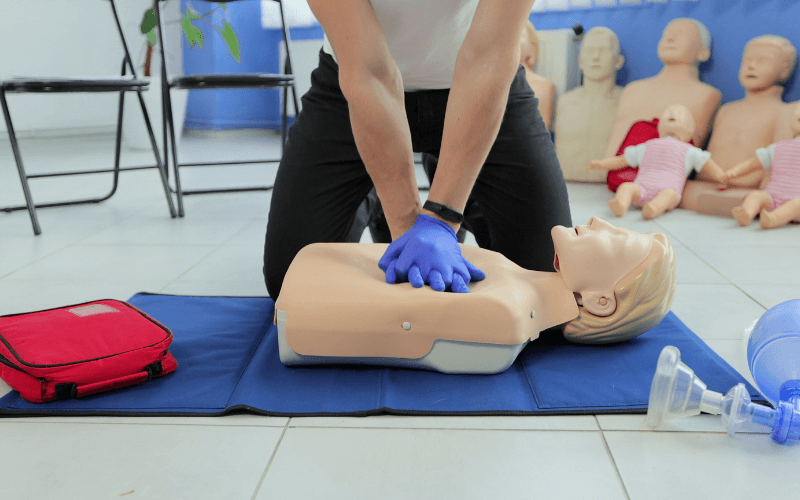10 Essential First Aid Skills to Learn for Carers
Carers play a vital role in ensuring the health and well-being of those they support, whether they are looking after elderly individuals, people with disabilities, or patients recovering from illness. One of the critical responsibilities of a carer is being prepared for medical emergencies.
Having the right first aid skills can mean the difference between life and death in urgent situations. To that end, Australian carers are encouraged to earn a nationally recognised certificate like HLTAID011, while New Zealand carers can complete first aid courses through the Red Cross or St. John.
In this blog:
Below are the essential first aid skills every carer should learn to improve their life-saving and emergency response abilities.
1. CPR (Cardiopulmonary Resuscitation)
CPR is a life-saving technique used when someone's heart has stopped beating or they are not breathing. Carers must learn how to perform chest compressions and rescue breaths effectively. You’ll need to:
Check for responsiveness and breathing
Call for emergency services if the person is unresponsive
Perform chest compressions at a rate of 100-120 compressions per minute
Deliver rescue breaths if trained to do so
Continue the first aid until medical help arrives
Automated External Defibrillators (AEDs) can also be crucial in emergencies and should be used if available.
Related reading: 5 Home Care Tips for Looking After Your Loved Ones
2. Choking Response
Choking can be a life-threatening emergency, especially for elderly individuals or people with swallowing difficulties. Carers should know the Heimlich maneuver (abdominal thrusts) and how to assist someone who is choking. Here are the steps to take:
Encourage the person to cough if they can still breathe
Perform back blows between the shoulder blades
Apply abdominal thrusts until the obstruction is cleared
Seek medical help if the person loses consciousness
If the person fails to respond, start standard CPR with chest compressions and rescue breaths. You can clear the airway by removing the object with your finger only if you can see it.
3. Managing Severe Bleeding
Uncontrolled bleeding can lead to shock and even death if not treated quickly. Carers should know how to:
Apply firm and direct pressure to the wound to stop the bleeding
Use clean dressings and bandages to cover the wound
Elevate the injured area above the level of the heart
Seek emergency medical assistance if the bleeding does not stop
Ensure the person stays warm and calm throughout, and don’t give them anything to drink or eat. If necessary and trained, you can use a tourniquet—this is usually a last resort for life-threatening bleeding.
4. Recognising and Responding to a Stroke
A stroke occurs when blood flow to the brain is interrupted. Recognising the signs and acting fast can significantly improve the chances of recovery. The acronym FAST helps carers remember what to look for:
Face: Is one side of the face drooping?
Arms: Can the person raise both arms?
Speech: Is their speech slurred or strange?
Time: Call emergency services immediately if you notice any of these symptoms.
Encourage the person to stay calm and place them in a comfortable position. Loosen or remove tight clothing, as it may restrict breathing.
Related reading: Practical Guide to Caring for a Loved One Who Has Suffered a Stroke
5. Treating Burns and Scalds
Burn injuries can occur from hot liquids, flames, or chemicals. The appropriate first aid treatment involves:
Cooling the burn under running water for at least 20 minutes
Covering the burn with a non-stick, sterile dressing
Avoiding the use of creams or ice on the affected area
Seeking medical attention for severe burns
Consider giving the person over-the-counter painkillers like Ibuprofen or paracetamol if they’re in pain.
6. Handling Seizures
Seizures can be frightening, but carers must know how to manage them safely. If someone has a seizure:
Keep them safe by removing nearby hazards
Place them on their side to prevent choking and aspiration
Do not restrain their movements or put anything in their mouth
Time the seizure—if it lasts more than five minutes, seek emergency medical help
Monitor their breathing and pulse. If the person is not breathing properly, you can begin CPR.
Related reading: Common Factors That Can Trigger Epileptic Seizures (Must Be Avoided)
7. Assisting with Diabetic Emergencies
Carers should be familiar with recognising the signs of high and low blood sugar in diabetics
Hypoglycaemia (low blood sugar): Sweating, confusion, shaking, dizziness, and loss of consciousness. Give the person a sugary drink or snack.
Hyperglycaemia (high blood sugar): Increased thirst, frequent urination, and fatigue. Encourage hydration and monitor symptoms.
Always seek medical advice if symptoms persist or worsen.
Most diabetic patients usually wear a warning necklace or bracelet. They may be carrying a glucose gel, tablets, or monitoring devices— check for these items when attending to them.
Related reading: 7 Diabetes Myths You Need to Know
8. Managing Falls and Fractures
Elderly individuals and those with mobility issues are at high risk of falls. If a person falls:
Do not move them if a fracture or spinal injury is suspected
Keep them calm and warm while waiting for medical help
Immobilise the injured area with a splint or bandage if necessary
Assess the situation, control bleeding if any, and monitor breathing. You can apply ice for 10-20 minutes at a time to the area.
Related reading: What to Do After a Serious Slip or Fall
9. Dealing with Shock
Shock occurs when the body is not getting enough blood flow, often due to severe injury or illness. Symptoms include pale skin, rapid breathing, and fainting. Carers should:
Lay the person down and elevate their legs (unless a spinal injury is suspected)
Control any bleeding by applying direct pressure
Keep them warm and reassured
Seek emergency medical assistance immediately
If the person is experiencing anaphylactic shock, administer an epinephrine auto-injector if available.
10. Recognising and Treating Allergic Reactions
Anaphylaxis is a severe allergic reaction that can be life-threatening. Signs include swelling of the face, difficulty breathing, and a drop in blood pressure. Carers must:
Identify the allergen and prevent further contact
Apply cool compresses to the affected area
Administer an epinephrine auto-injector (if available and prescribed)
Call emergency services immediately
Keep the person lying down and monitor their breathing
Continue to monitor the person's condition and provide care as needed until emergency medical services arrive.
Respond Faster to Emergencies with Tunstall Healthcare
Having essential first aid skills is a fundamental requirement for carers. From handling minor injuries to responding to life-threatening emergencies, being prepared can save lives. Regular first aid training and refresher courses ensure carers stay up to date with the latest techniques and best practices.
In addition to learning these skills, carers should encourage their patients and loved ones to use emergency devices and monitors like personal alarms and fall detectors. These devices ensure safety and independence for wearers while enabling faster response times from carers and emergency services.
Contact Tunstall Healthcare today to discover how our solutions empower carers to safety of wearers.
Further reading: Helpful Tips for New Carers Starting Their Caregiving Journey





